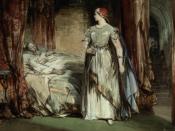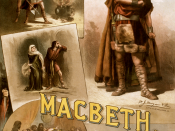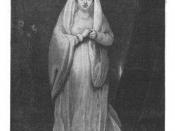Macbeth's theme in one word is EQUIVOCATION (of double or doubtful meaning, questionable, ambiguous). Equivocation is prevalent throughout the play. Lady Macbeth uses it a lot, and suggests it to her husband when she says "...look like the innocent flower / But be the serpent under 't..." (Act I, Scene 5, 64-65)
In other words, the idea or theme in the play is "Fair is foul, foul is fair." Basically, this means that appearances can be deceiving. What appears to be good can be bad, and this is seen in such things as the deceptive facade of Lady Macbeth and in the predictions of the witches.
In the first scene of the first act, three witches plan their next meeting in which they will encounter Macbeth. It is in this scene that the theme is first presented, as the tree witches chant, "Fair is foul, and foul is fair, hover through the fog and filthy air" (Act I, Scene 1, 11-12).
The witches meet again in scene three of act one. One of the witches discusses a curse she has placed on a woman's husband, because she refused to share her food. This display of evil powers and spitefulness suggests that the witches may have some influence in the development of the theme.
To the Weird Sisters what is ugly is beautiful, and what is beautiful is ugly: "Fair is foul and foul is fair". Throughout the play, fair appearances hide foul realities.
Macbeth enters during scene three of act one along with Banquo, arriving from a victorious battle. He uses the motif to describe the day as "So foul and fair a day I have not seen" (Act I, Scene 3, 38). When Macbeth and Banquo first see the weird sisters, Banquo is horrified by their hideous...


